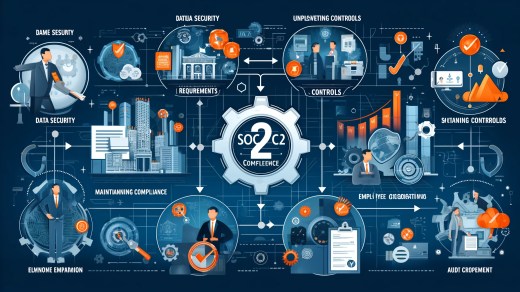In an era where cloud infrastructure is integral to business operations, ensuring robust security measures is paramount. Cloud Security Posture Management (CSPM) plays a crucial role in identifying and mitigating vulnerabilities within cloud environments.
At DevOps Oasis, we understand the significance of a well-implemented CSPM strategy for safeguarding valuable data and maintaining compliance. This blog post delves into the essential components, best practices, and leading tools for effective CSPM.
What Is CSPM?
Cloud Security Posture Management (CSPM) is a comprehensive approach to manage and improve the security posture of cloud environments. It focuses on identifying and mitigating misconfigurations, ensuring compliance, and continuously monitoring security practices. In simpler terms, CSPM keeps your cloud infrastructure secure and compliant.
Definition and Importance of CSPM
CSPM helps organizations recognize vulnerabilities in their cloud environments, such as misconfigurations and policy violations. According to Gartner, 99% of cloud breaches through 2025 will be the customer’s fault due to misconfigurations. This statistic underscores the critical role CSPM plays in preventing breaches and protecting sensitive data.
Key Components of CSPM
-
Visibility: Continuous visibility into cloud assets, ensuring all resources are accounted for and properly configured.
-
Compliance Monitoring: Ensuring adherence to regulatory requirements like GDPR, HIPAA, and PCI-DSS.
-
Threat Detection: Identifying potential threats and vulnerabilities in real-time.
-
Automation: Automating remediation of detected issues to reduce manual workload and response times.
-
Identity and Access Management: Managing who can access your cloud resources and ensuring they have the appropriate permissions.

Overview of Market Trends and Adoption Statistics
The global CSPM market was valued at USD 4.70 billion in 2022 and is expected to grow at a CAGR of 10.4% until 2030. This growth is driven by increasing cloud adoption and the prevalence of security incidents. Here are some key statistics:
-
81% of organizations experienced a cloud-related security incident in the last year.
-
94% of enterprises use cloud services, with 67% of their infrastructure being cloud-based.
-
82% of breaches involved cloud data, emphasizing the need for robust CSPM solutions.

For more about securing cloud environments, check our guide on best practices.
Best Practices for CSPM Implementation
Regular Cloud Configuration Assessments
Maintaining consistent assessments of your cloud configurations is key to avoiding vulnerabilities. According to a study by Palo Alto Networks, up to 65% of cloud incidents are due to misconfigurations. Regular assessments help identify these issues before they become problematic.

Utilize tools like AWS Config or Azure Security Center. These tools offer real-time evaluation and keep a history of your configurations. Regularly analyze these histories to track and resolve any recurrent issues. Implementing a structured assessment schedule, such as weekly scans, ensures continuous oversight.
Continuous Monitoring and Threat Detection
Real-time monitoring is non-negotiable. A study by IBM found that organizations with continuous monitoring reduce breach costs by 21%. Monitoring services like Google Cloud’s Security Command Center can provide end-to-end visibility into your environment.

-
Invest in AI-driven tools for enhanced threat detection.
-
Set up alerts for immediate notification of anomalous activity.
-
Integrate monitoring solutions with incident response tools to streamline threat management.
Automated Remediation Tools
Automation is a game-changer in CSPM. The Ponemon Institute reports that automated remediation can reduce time to containment by 27%. Tools like Terraform can dynamically adjust configurations to align with your security policies.
Here are the benefits of using automated remediation solutions:
-
Speed: Immediate action on detected issues.
-
Consistency: Ensures compliance without human error.
-
Scalability: Easier to manage across extensive cloud infrastructure.
For additional insights, you can explore how automation enhances cloud environments.
By integrating these strategies, your cloud security posture becomes more robust, efficient, and resilient.
Which CSPM Tools Are Leading?
There are several robust CSPM tools available today that can significantly enhance your cloud security. In this section, we’ll look at the leading CSPM tools, compare their features, and provide real-life examples of their successful implementation.
Top CSPM Tools in 2023
-
Palo Alto Networks Prisma Cloud: As a comprehensive tool, Prisma Cloud offers real-time visibility, threat detection, and compliance monitoring across multi-cloud environments. Given its extensive security capabilities, it’s a popular choice among enterprises.
-
AWS Security Hub: Specifically designed for AWS environments, it provides centralized security management and compliance checks. AWS Security Hub can integrate seamlessly with other AWS services, making it highly efficient for users of Amazon’s ecosystem.
-
Azure Security Center: This tool is tailored for Microsoft Azure. It provides advanced threat protection and ensures compliance with standards like GDPR and HIPAA. Its seamless integration with other Azure services makes it a cornerstone for organizations using Microsoft’s cloud platform.
-
Google Cloud Security Command Center: Google Cloud’s offering focuses on providing comprehensive visibility and actionable insights into security and data risks. Its integration with Google’s advanced AI and analytics tools sets it apart in threat detection.
Comparison of Features
-
Prisma Cloud: Supports multi-cloud, advanced threat detection, real-time compliance monitoring.
-
AWS Security Hub: Centralized alerts, integrates with AWS services like GuardDuty, Compliance checks.
-
Azure Security Center: Continuous security assessment, advanced data protection, strong compliance tools.
-
Google Cloud Security Command Center: AI-driven insights, integrated vulnerability scanning, extensive monitoring capabilities.
Case Studies of Successful Implementations
Johnson & Johnson: Using Palo Alto Networks Prisma Cloud, Johnson & Johnson improved their cloud security posture by 30% in just six months. The tool’s multi-cloud support and real-time threat detection helped streamline their security processes and ensure compliance with rigorous healthcare standards.
Expedia Group: By deploying AWS Security Hub, Expedia Group reduced the average time to detect threats by 35%. Integrating Security Hub with GuardDuty and AWS Config allowed them to automate their response to incidents, considerably lowering the risk of potential breaches.
Heathrow Airport: Implementing Azure Security Center enabled Heathrow Airport to enhance their compliance rating for GDPR and other regulations by 25%. The tool’s continuous assessment and protection capabilities ensured that all their cloud assets were secure and up-to-date with compliance requirements.

-
Palo Alto Networks Prisma Cloud: Multi-cloud support, real-time threat detection, streamlined processes.
-
AWS Security Hub: Reduced detection time by 35%, integration with GuardDuty, automated responses.
-
Azure Security Center: GDPR compliance improved by 25%, continuous assessment, protection capabilities.
These examples underscore the value these tools bring to the table, whether it’s through advanced threat detection, compliance, or real-time monitoring. Each tool has unique strengths, making it crucial to choose one that aligns with your specific cloud security requirements.
For additional insights into optimizing your cloud security practices, check out our guide on effective resource allocation.
In the next chapter, we’ll explore emerging trends in CSPM and how they are shaping the future of cloud security.
Conclusion
Cloud Security Posture Management (CSPM) offers numerous benefits that significantly bolster your security framework. It ensures visibility, helps maintain compliance, automates remediation, and enhances threat detection. With 81% of organizations experiencing a cloud-related security incident in the past year, CSPM is a necessity rather than an option.

Comprehensive CSPM tools like Palo Alto Networks Prisma Cloud, AWS Security Hub, and Azure Security Center provide robust solutions tailored to various environments. These tools streamline security processes and improve compliance metrics, as evidenced by the success of companies like Johnson & Johnson and Heathrow Airport.
Looking ahead, the future of CSPM is promising. AI integration and enhanced features will make the tools even more efficient and essential for cloud security. Increasing cloud adoption and stricter regulations will continue to drive the growth of CSPM solutions.
To effectively guard your cloud infrastructure, prioritizing cloud security measures is essential. At DevOpsOasis.com, we specialize in providing deep insights and comprehensive solutions for your DevOps and cybersecurity needs. Join us to stay ahead in the ever-evolving landscape of cloud security.



















